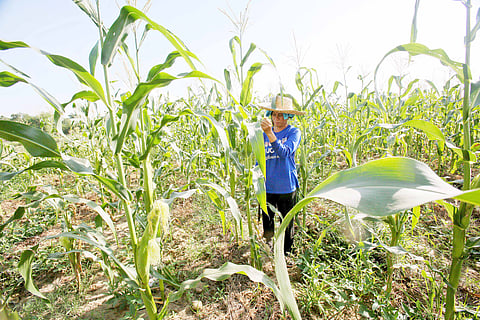
- HEADLINES
- NEWS
- PAGE THREE
- COMMENTARY
- BUSINESS
- LIFE
- ACTION
- GLOBAL GOALS
- SNAPS
- DYARYO TIRADA
- AIF
- MORE

In the midst of the searing heat gripping the country, the evident impact of climate change on human well-being highlights their interconnectedness, straining public health and emphasizing the urgent need to address this critical issue as temperatures continue to rise and extreme weather events become more frequent.
From 1 January to 18 April 2024, the Event-based Surveillance and Response System of the Department of Health (DoH) recorded 34 cases of heat-related illnesses, tragically resulting in six deaths. In 2023, DoH noted that there were 513 heat-related illnesses reported throughout the entire year.
These statistics emphasize the urgency of addressing the nexus between climate change and public health, which has never been more evident.
The World Meteorological Organization (WMO) issued a red alert on the worsening effects of climate change. According to its State of the Global Climate 2023 report, the average near-surface temperature has risen to 1.45 degrees Celsius above pre-industrial levels — 0.5°C away from the 1.50°C ‘safe’ pre-industrial levels as set during the Paris Agreement.
Last year’s 1.45°C marked the hottest average global temperatures since recording began 174 years ago, with ocean temperatures also reaching a 65-year high. Without any sign of decreasing, global temperatures this year are expected to exceed 2023’s heat records.
The Philippines continues to experience some of its warmest days, with the heat index — a measure indicating the level of discomfort humans perceive due to the combination of high temperature and humidity — reaching 50°C.
The Philippine Atmospheric, Geophysical and Astronomical Services Administration has warned of heat indices reaching 'danger' levels, ranging between 42 and 51°C in many parts of the country.
Extreme heat directly impacts individuals with broader socio-economic implications, particularly for vulnerable communities such as farmers and fisherfolk. These populations face increased heat exposure and associated health risks, impacting both physical health and economic livelihoods.
Economically, it reduces productivity, damages crops, disrupts fisheries, and increases costs due to the need for additional cooling and irrigation infrastructure. Health-wise, heat exposure leads to heat-related illnesses, exacerbates respiratory issues due to air pollution, and promotes the spread of communicable diseases like malaria and dengue. The increased risk of non-communicable diseases, such as cardiovascular problems, adds to the health burden.
Furthermore, extreme heat leads to forest fires, wreaking havoc on ecosystems, economic activities, and human health. In 2023, the Bureau of Fire Protection (BFP) recorded 1,484 total number of forest and grass fires in the entire country. Early this year, in the hinterlands of the Cordillera region, 86 forest fires were reported from January to March. On 17 April, Mount Arayat in Pampanga also experienced its second fire of the month, following a bush fire on 2 April that destroyed 12 hectares, including parts of the protected forest reservation. These fires result in immediate tree and vegetation loss and disrupt biodiversity, endangering species and upsetting the ecosystem balance. Additionally, the smoke and haze from the fires pose health risks to nearby communities, particularly those with respiratory conditions.
Together, these impacts can lead to increased migration, displacement, and greater vulnerability, affecting rural communities and further worsening poverty.
Anecdotal accounts from communities across the country underscore the personal toll of extreme heat on individuals and families. In Isabela Province, an elderly farmer took a break from upland farming activities due to his high blood pressure after experiencing dizziness and loss of consciousness in extreme heat conditions. Similarly, in Romblon, a fisherman can no longer endure the heat on the open sea, affecting his ability to earn a living.
The number of Filipinos potentially impacted by extreme heat (i.e., at heat indices greater than 42°C), is projected to reach up to 11 million by 2030 and may increase to 74 million by 2050, according to Boston Consulting Group’s analytics.
Addressing the underlying causes of climate change is vital for preventing the escalation and exacerbation of extreme weather events in the future. Transitioning to clean energy, promoting sustainable transportation, and conserving natural habitats are crucial for both mitigating this global issue and ensuring human well-being.
“In confronting the challenges posed by climate change, we must recognize that the health of our planet and the health of our people are intricately linked. Taking bold climate action is not just a choice; it is a necessity for safeguarding our collective future,” said Secretary Robert E.A. Borje, vice chairperson and executive director of the Climate Change Commission.
At present, efforts to address the health impacts of climate change are being pursued at both the national and local levels, with initiatives focusing on climate-resilient health systems, climate-smart agriculture, and community-based adaptation. Strengthening public health infrastructure and integrating climate change adaptation measures into policies and programs are crucial steps toward protecting communities in the face of climate-related hazards.
“As the mercury continues to rise, the imperative for action becomes increasingly urgent. Ambitious climate action is not just a matter of ecological stewardship. It is a prescription for public health, with far-reaching benefits for individuals and communities alike,” Borje emphasized.
